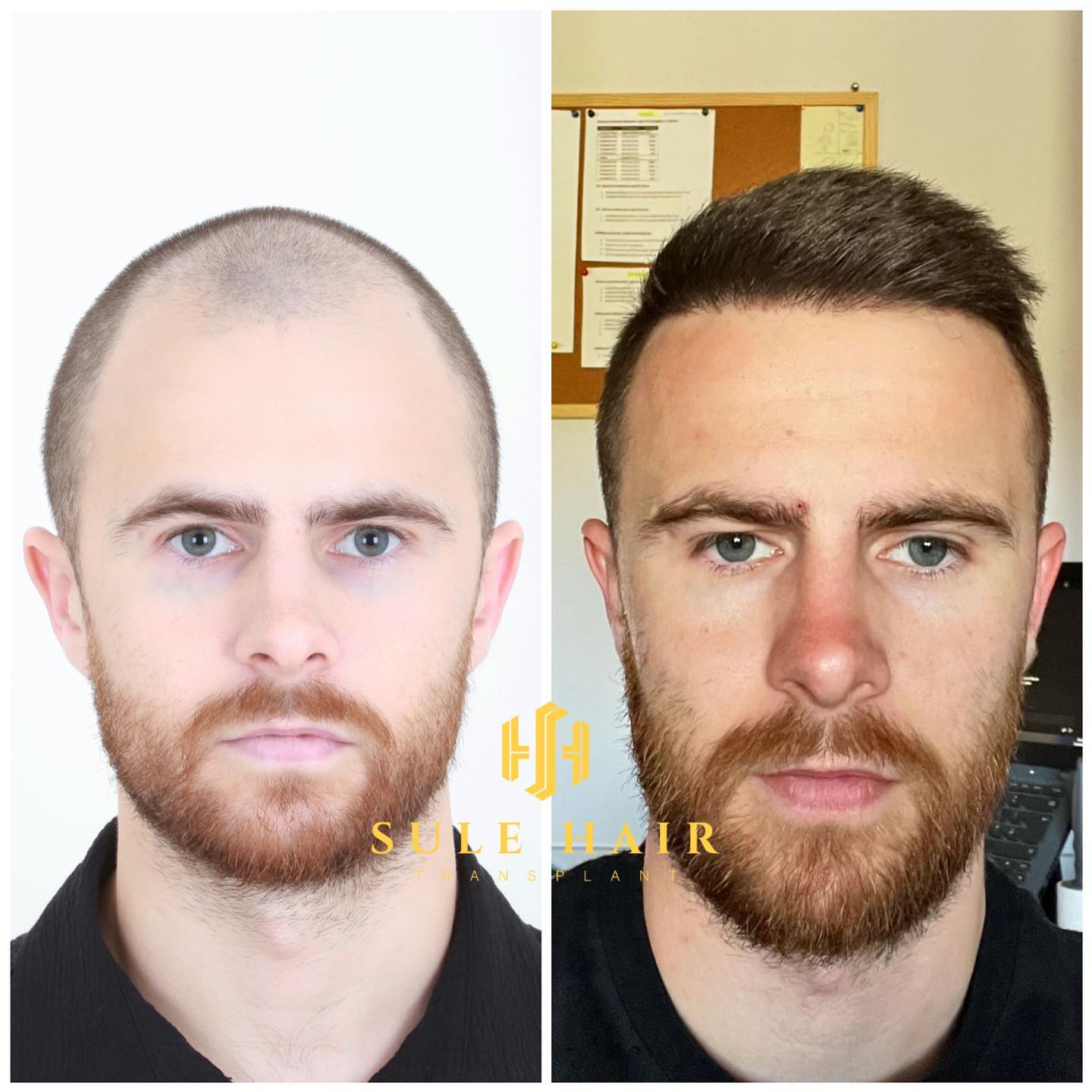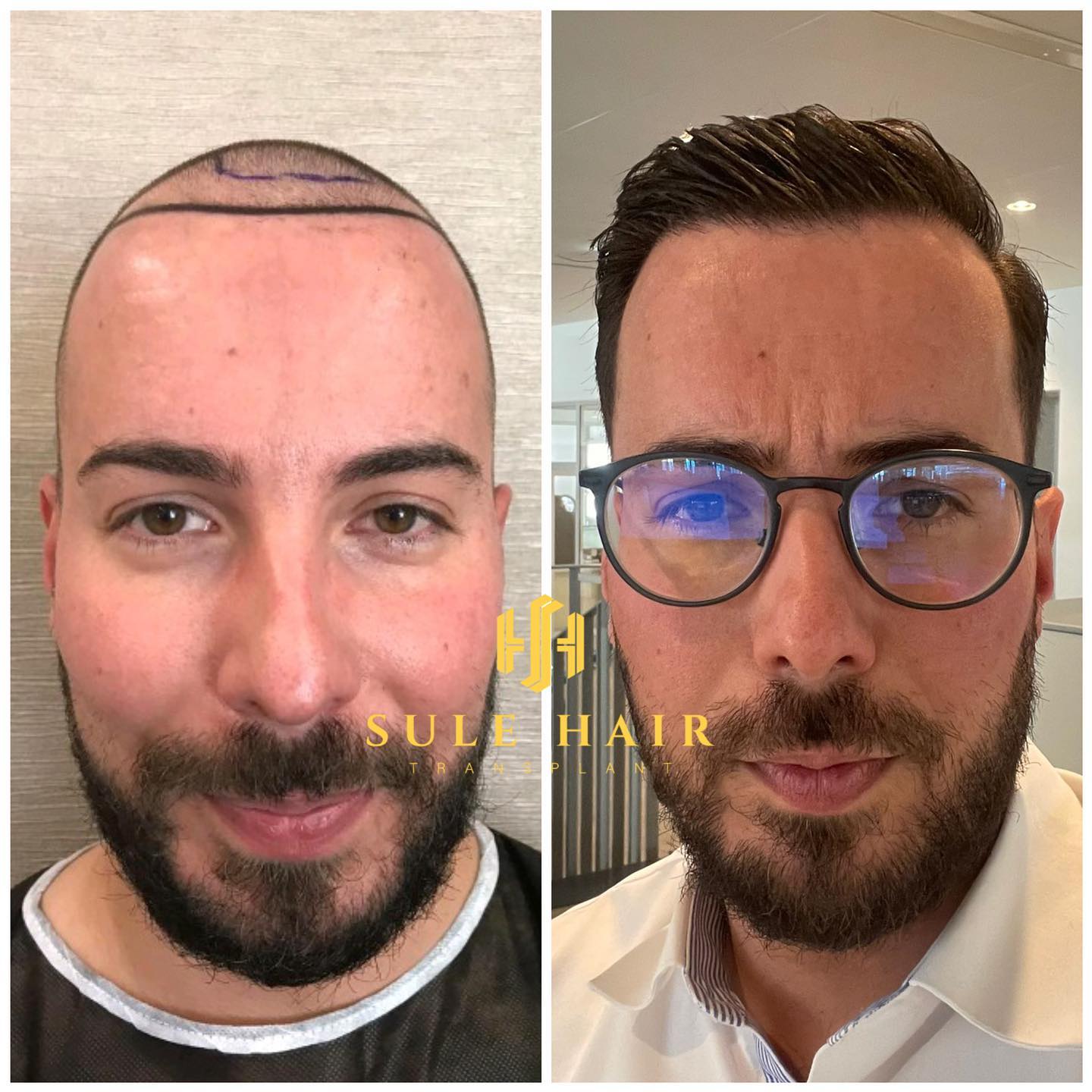Istanbul has emerged as the world’s premier destination for hair transplant surgery, marking Turkey as a leading country for those seeking high-quality procedures at competitive rates. With over 100,000 operations conducted annually and a booming medical tourism landscape attracting about 700,000 visitors each year specifically for hair transplants, the allure of achieving a transformed appearance is undeniable. The combination of expert care and affordable hair transplant costs in Turkey makes it a magnet for individuals aiming to enhance their hairline with state-of-the-art treatments.
As we delve into the journey of hair restoration, we’ll explore the critical stages, from pre-operative considerations to the long-term results and expectations. This article will shed light on the transformative power of Turkey hair transplant before and after pictures, showcasing the dramatic changes and providing insights on post-operative care and tips. Whether you’re contemplating how much a Turkey hair transplant costs or are interested in understanding the complete process, our guide will navigate you through the essentials of achieving your desired look, ensuring a comprehensive understanding of hair transplants in Turkey.
The Allure of Turkey for Hair Transplants
Turkey’s reputation as a leading destination for hair transplant surgery is built on a foundation of affordability, high-quality medical services, and access to advanced surgical techniques. Here’s a closer look at what makes Turkey a go-to choice for individuals seeking hair restoration:
- Affordability and Quality:
-
- The cost of hair transplant procedures in Turkey is significantly lower than in Europe and the UK, with prices up to 90% cheaper. Despite the lower cost, clinics like Vera Clinic in Istanbul maintain high standards with state-of-the-art equipment and expertise. The average cost of a hair transplant in Turkey ranges between $1,800 and $4,000, making it an affordable option for many.
- Advanced Techniques and High Success Rates:
-
- Turkey is home to over 100 clinics that offer a wide range of services, from follicular unit extraction (FUE) to follicular unit transplantation (FUT). Clinics such as Cosmedica and Vera Clinic are known for their high success rates, around 98%, due to highly qualified doctors and cutting-edge medical technology. These clinics specialize in various procedures, including FUE, DHI (direct hair implantation), Micro Sapphire DHI, and more, ensuring natural and successful results.
- Comprehensive Care and Hospitality:
-
- Many clinics offer free perks, including airport-hotel transportation, flight tickets, and accommodation in good hotels, making the entire experience hassle-free for international patients. The hospitality extends beyond the clinics, with Istanbul itself being a vibrant city known for its history, culture, and architecture, providing a great place to explore before or after the procedure.
Despite its many advantages, it’s important for potential patients to exercise caution and conduct thorough research. The presence of unlicensed surgeons offering black-market hair transplants has led to a notoriously poor safety record in some instances. Prospective patients should consider factors such as patient experiences, before and after photos, the medical team’s specialization, and clinic certifications to ensure a safe and successful hair transplant experience in Turkey.
Pre-Operative Considerations
Embarking on a hair transplant journey in Turkey requires meticulous pre-operative preparation to ensure the best possible outcomes. The process, typically spanning 4–10 hours based on the number of follicles transplanted, starts long before the day of the surgery. Here are some essential considerations and steps to follow:
Pre-Operative Checklist:
- Eligibility: Not everyone is suitable for a hair transplant. Individuals who are fully bald or have an insufficient donor area are unlikely to qualify. It’s crucial to have a preliminary assessment to determine eligibility.
- Package Inclusions: Understanding what your chosen package offers is vital. For instance, the FUE Plus Gold Technique Package encompasses a range of services, including a blood test, medication, foam, mesotherapy, gold cream, and more, along with logistics support like private airport transfers and accommodation.
- Preparation Guidelines:
-
- Medical and Lifestyle Precautions:
-
- Discontinue alcohol and aspirin-related products 3 days prior.
- Cease consumption of vitamins or high-vitamin-content drinks 2 days before the surgery.
- Avoid heavy exercises 5 days before the procedure.
- Inform the clinic about any regular medication and if you have conditions like diabetes or HIV/hepatitis.
- Day Before and After the Surgery:
-
- Wash your scalp with shampoo and have a light breakfast, avoiding caffeine.
- Wear a button-down shirt for easy changing without disturbing the transplanted grafts.
- Fast for at least 8 hours if sedation is required; however, lunch will be provided during the procedure.
Important Dos and Don’ts:
- Dos:
-
- Shower and wash your hair on the morning of the procedure.
- Keep hair at least 4 mm long for visibility of bald and sparse areas.
- Wear old, comfortable clothes you don’t mind getting stained.
- Don’ts:
-
- Do not take any medication or supplements that could thin the blood, such as aspirin, ibuprofen, or certain vitamins, without consulting the clinic.
- Stop smoking at least one day before and refrain for a week after the surgery to not impede blood flow and hair regrowth.
- Avoid using any hair treatment products that increase blood flow to the scalp.
Day of the Operation:
- Ensure you have arranged for a ride home by a family member or friend post-operation, as you will be under the influence of sedation.
- Maintain a calm demeanor, avoiding chewing gum, excessive talking, or using cell phones during the operation to ensure the best focus and results from the medical team.
By adhering to these pre-operative considerations, patients can significantly enhance their readiness for a hair transplant in Turkey, setting the stage for a successful procedure and optimal hair transplant before and after results.
Understanding the Hair Transplant Procedure
Understanding the hair transplant procedure in Turkey involves a deep dive into the techniques and technologies employed to ensure successful outcomes. The journey from extraction to transplantation is meticulously planned and executed, ensuring patients leave with not just more hair but also increased confidence.
Follicular Unit Extraction (FUE) Process:
- Extraction: Individual hair follicles are extracted from the nape area with a tiny, hollow needle, minimizing tissue damage and reducing the risk of infection. This method is notable for its precision and minimal invasiveness, using microblades with punches ranging from 0.6 to 0.7mm in diameter.
- Transplantation: Depending on the patient’s needs, between 1,800 and 6,000 grafts can be transplanted in one session. The FUE method allows for a detailed and natural-looking placement of these grafts, ensuring the final appearance is as close to the patient’s natural hair pattern as possible.
- Recovery: Post-procedure, FUE is celebrated for its quick recovery time and lack of visible scarring, making it a preferred choice for many seeking hair transplant solutions in Turkey.
Advanced Techniques for Enhanced Results:
- Sapphire FUE: utilizes transparent sapphire blades for precise incisions, allowing for denser follicle placement. This technique enhances the accuracy of implantations, leading to more natural and fuller results.
- DHI (Direct Hair Implantation): This method does not require shaving the head and allows for direct implantation of hair follicles into the scalp, offering precise control over the angle, direction, and depth of each graft.
- Comparison: While traditional FUE is renowned for its effectiveness and minimal downtime, Sapphire FUE and DHI offer advancements in precision and density, catering to different patient needs and preferences.
Potential Risks and Considerations:
- Despite the high success rates, patients should be aware of potential risks such as bleeding, infection, swelling, and temporary numbness. These are rare and can be significantly minimized when the procedure is performed by experienced surgeons in reputable clinics.
- It’s crucial to remember that the success of a hair transplant also depends on the quality and quantity of the donor’s hair. Surgeons can only transplant hair from areas where it is abundant to areas of thinning or baldness.
In summary, the hair transplant process in Turkey is characterized by the use of advanced techniques and technologies, ensuring patients can achieve natural-looking and long-lasting results. With careful consideration of the type and number of grafts and the choice of procedure, individuals can look forward to a transformation that goes beyond just hair growth, enhancing their overall appearance and self-esteem.
The Transformation: Before and After Pictures

The journey from the initial hair transplant procedure to witnessing the full results is a transformative experience for patients, marked by several key milestones:
- Initial Recovery and Hair Growth Timeline:
-
- Week 1: Scabs form on the scalp, a normal part of the healing process. They typically clear within the first week, signaling the beginning of the recovery phase.
- Month 3: Hair growth starts to become noticeable. At this stage, new hair follicles have taken root and begun to grow.
- Month 6: The growth becomes more visible, and patients start to see significant changes in their hairline and density.
- Month 18: This is when patients perceive the full result of the implant on the top of the scalp. By now, the transplanted hair has fully grown in and blended with the natural hair, offering a much fuller and more natural-looking head of hair.
- Visual Evidence of Transformation:
-
- Clinics often provide before and after photos of their patients, showcasing the dramatic changes and results of their procedures. These visuals serve as compelling evidence of the effectiveness of hair transplant surgeries.
- A dedicated section for before-and-after photos is commonly found on clinic websites, divided based on the number of grafts. Categories typically include:
-
- 5000-4000 grafts
- 4000-3000 grafts
- 3000-2000 grafts
- 3000-2000 grafts (female)
- 2000-1000 grafts (female)
- These categorizations help prospective patients gauge what results they might expect based on their own hair loss and the number of grafts they may require.
This structured approach to showcasing the outcomes not only helps in setting realistic expectations but also in illustrating the clinic’s expertise and success in performing hair transplants. The before and after photos act as a visual journey, highlighting the profound impact a hair transplant can have on an individual’s appearance and, by extension, their confidence and quality of life.

Post-Operative Care and Tips
Navigating through the post-operative phase of a hair transplant is crucial for ensuring the best possible outcomes. Here, we delve into the essential care and tips that patients should adhere to after undergoing a hair transplant procedure:
Immediate Post-Operative Care:
- First 3 Days:
-
- Avoid touching the transplanted area to prevent dislodging the grafts.
- Sleep on your back using a neck pillow to minimize swelling and protect the grafts.
- Abstain from alcohol, cigarettes, and any tobacco products to facilitate healing.
- Use paper napkins for drying your head gently; avoid towels or cotton that might stick to the grafts.
Pain Management and Swelling Reduction:
- Pain Relief: Mild pain can occur, which is manageable with over-the-counter painkillers.
- Swelling Management: Swelling around the forehead and eyes is common, which can last 2–5 days. Using a drug like Dexamethasone and sleeping with the head elevated on pillows can help reduce these symptoms.
Hair Care and Activity Post-Op:
- Hair Washing Instructions:
-
- From day 3, start washing your head with a special medical shampoo. Lather the shampoo in your hands and apply gently without rubbing. Rinse thoroughly to avoid residue.
- Use a bath sponge to disperse foam without touching your head directly.
- Continue daily shampooing to remove scabs, and use the special shampoo until the bottle is empty.
- Physical Activity:
-
- Short walks and light exercises that don’t cause excessive sweating are encouraged immediately after the procedure.
- After 7-9 days, patients can resume more active exercise. Shower shortly after workouts to minimize infection risks.
Sun Exposure and Hair Manipulation:
- Avoid direct sunlight for the first 2 weeks post-op. For the first 6 months, wearing headwear when in the sun is recommended to protect the transplanted area.
- Wait for 3 months post-surgery before engaging in any scalp manipulation, including using PRP, mesotherapy, or hair loss sprays.
Adhering to these post-operative care instructions and tips can significantly impact the healing process and the overall success of the hair transplant. By taking the necessary precautions and following the recommended guidelines, patients can enjoy the full benefits of their hair transplant, witnessing a transformation that enhances not only their appearance but also their self-confidence.

Long-Term Results and Expectations
Hair transplant procedures in Turkey not only offer a transformative experience but also promise lasting results. Here’s what patients can expect in the long term:
- Genetic Resistance and Ongoing Care:
-
- Transplanted follicles are genetically resistant to baldness, ensuring the permanence of the procedure.
- To combat potential thinning around transplanted areas, ongoing care with medications like Finasteride and Minoxidil is advised.
- Success Rates and Aging:
-
- The success rate for FUT and FUE surgeries exceeds 90% after 10 years, underscoring the procedures’ effectiveness.
- As patients age, transplanted hair will gray or white, mirroring the natural aging process of indigenous hair.
- Considerations for Future Procedures:
-
- Initial overharvesting might not present immediate issues but can complicate potential future procedures due to insufficient donor hair.
- Despite the upfront costs, hair transplantation offers a long-term solution that could be more economical than ongoing temporary fixes.
Cost and Experience:
- The average cost for a hair transplant in Istanbul is $1,840, with a price per graft averaging $0.69, making it a financially accessible option for many.
- With surgeons averaging twelve years of experience, patients can feel confident in the professionalism and skill level offered in Turkey’s clinics.
Innovative Treatments:
- Stem cell hair transplant, a cutting-edge therapy, utilizes stem cells to strengthen and regenerate existing hair follicles, offering another avenue for those seeking hair restoration.
In summary, patients opting for hair transplant surgeries in Turkey can look forward to durable and aesthetically pleasing results. With careful planning and adherence to post-operative care, the journey towards hair restoration not only enhances one’s appearance but also boosts confidence, with Turkey remaining at the forefront of offering cost-effective and high-quality hair transplant services.
Conclusion
Through the detailed journey from preparation, operation, and post-operative care, we’ve explored the transformative potential of hair transplant surgeries in Turkey. The allure of high-quality procedures at competitive prices, coupled with the advanced techniques and comprehensive care available, positions Turkey as a premier destination for individuals seeking to rejuvenate their appearance. The success stories, underscored by the compelling before and after photos, not only demonstrate the expertise found in clinics like the Sule Hair Clinic Istanbul but also offer hope and a path forward for those grappling with hair loss.
As we reflect on the long-term benefits and the nuanced considerations of hair transplants in Turkey, it’s clear that the decision to undergo such a procedure is not just about restoring hair but also about regaining confidence and improving quality of life. Those considering this life-changing step are encouraged to conduct thorough research to ensure a safe and satisfactory experience. For anyone ready to take the next step in their hair restoration journey, exploring the offerings at Sule Hair Clinic Istanbul could mark the beginning of a transformative experience.

FAQs
How long should I plan to stay in Turkey for a hair transplant procedure?
A typical hair transplant trip to Istanbul requires a 4-day stay, which includes 3 nights. However, if your schedule does not permit this, it is possible to arrange a shorter visit of one or two nights.
Are hair transplants permanent, and what can be expected after 10 years?
Yes, hair transplant results are generally permanent and can last a decade or more. To ensure the longevity of the transplant, it is important for patients to avoid tobacco and alcohol and protect their scalp from sun damage and physical injuries.
At what age is it most appropriate to get a hair transplant?
While individuals over the age of 18 can undergo a hair transplant, it is usually recommended to wait until after the age of 25. This is because hair loss patterns may not be fully established in younger men, which could affect the long-term success of the procedure.












